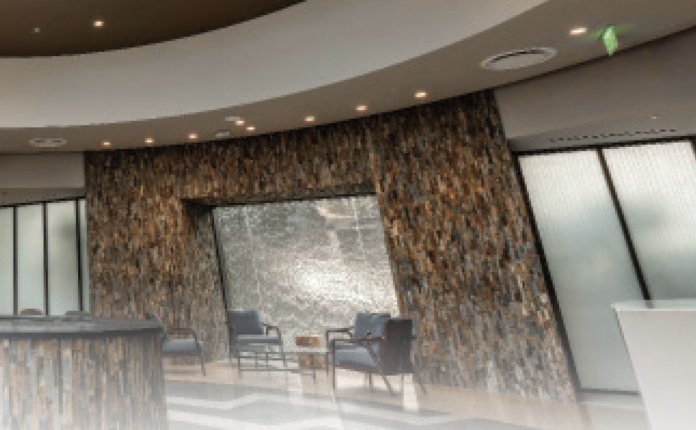Tribal Chairman Reid D. Milanovich is looking forward to welcoming visitors from around the world to the new Agua Caliente Cultural Museum when it opens at the Agua Caliente Cultural Plaza later this year. Spreading across 5.8 acres in downtown Palm Springs, the new Agua Caliente Cultural Plaza is one of the country’s largest Native American museums and cultural centers operated by a federally recognized Native American tribe.
It was developed both to inform visitors about the Tribe’s history and culture in the area and also to celebrate and preserve traditions for today’s Agua Caliente people. The presence of the Agua Caliente Band of Cahuilla Indians in the area now known as Palm Springs precedes any written calendar, record, or memory. The Agua Caliente Indian Reservation was established in 1876 and expanded in 1877. The cities of Palm Springs, Cathedral City, and Rancho Mirage share boundaries with the Agua Caliente Indian Reservation.
Today, the Tribe has more than 500 Tribal members and is one of the largest employers in the Coachella Valley with its Tribal government, three casinos, a resort hotel and spa with a fuel station in Rancho Mirage, and attractions such as the Indian Canyons, Tahquitz Canyon, Indian Canyons Golf Resort, and the new Agua Caliente Culture Plaza in downtown Palm Springs, which includes the Agua Caliente Cultural Museum and the recently opened The Spa at Séc-he. “Our ancestors have been here in this area now known as Palm Springs since time immemorial,” Tribal Chairman Reid D.
Milanovich said at the March 31, 2023 opening of The Spa at Séc-he, “and, from a scientific viewpoint, we have archeological evidence that our ancestors have been here for more than 8,000 years.” Reflecting on that for a moment, that’s more than 300 generations. For the Tribe, no site is more significant than the Agua Caliente Hot Mineral Spring on its ancestral land in downtown Palm Springs.
Its pure mineral water provided a place for spiritual connection and physical healing. The Agua Caliente people have called the spring Séc-he, the Cahuilla term for “the sound of boiling water,” since the beginning. “The opening of The Spa at Séc-he is a defining moment for the Tribe,” says Chairman Reid D. Milanovich. “The hot spring water means everything to us. It’s at the heart of Tribal life, and has been a cultural resource for us and our ancestors for thousands of years. The power of these healing waters is real, and we are proud to offer the experience to all who come.” The Tribe broke ground on the Agua Caliente Cultural Plaza project in May 2018. Then, by July of that year, construction on the project was paused for more than six months in order to conduct one of the largest indigenous archeological recovery projects ever in California. The Tribe worked to ensure that any unearthed artifacts would be preserved. They discovered a rich trove of items—spear and projectile points, grinding stones and tools, and clam and abalone shell beads. Carbon dating of some these items suggests that the site’s human presence dates as far back as more than 8,000 years.
Experiencing the Agua Caliente World
The new Cultural Plaza defines who the Agua Caliente people are in the 21st century by celebrating the Tribe’s culture, heritage and, most importantly, the Tribe’s traditions. The Cultural Plaza’s striking contemporary design and bespoke terrazzo floors in the museum and spa buildings draw inspiration from the Agua Caliente’s basketmaking tradition. In fact, the tile patterns come directly from designs on baskets in the Tribe’s own history. Basket weaving is an integral part of Cahuilla culture.
According to the Tribe, the Agua Caliente traded baskets and used them in daily life. Beyond the practical uses, baskets shared stories of the Cahuilla people through their iconography of plants and animals, particularly birds and snakes. Today’s Agua Caliente people are keeping alive basket weaving and other traditions, such as pottery, by taking classes offered by the Tribe to learn these ancient crafts. More Tribal members are also studying the Cahuilla language, which is considered critically endangered and only spoken fluently by a handful of people.
The Agua Caliente Cultural Museum will be a cultural heritage attraction and an educational institution with a mission to share and celebrate the story of the Agua Caliente Band of Cahuilla Indians. Many artifacts, such as manos, metates, and projectile points, that were recovered from the Plaza site during construction in 2018 will be displayed to demonstrate the Tribe’s enduring habitation of the region. The Agua Caliente Cultural Plaza will be a cultural heritage destination. A sacred place for Tribal members and guests to celebrate the history, culture, traditions, and modern life of the Agua Caliente Band of Cahuilla Indians.


